SWT/KWS MARA MOBILE VETERINARY UNIT September 2022



15 Cases in September 8 Poaching Cases 5 Elephant Cases

September
 Report by Dr. Ndambiri Ephantus
Report by Dr. Ndambiri Ephantus
September was initially dry and cold, but towards the end of the month we experienced some sunshine, wind and rain. We are optimistic that these favourable weather condition will alleviate resource scarcity so that people and wild animals can coexist peacefully.

It has been a busy month with cases attended to ranging from clinical interventions to autopsies. Most of the clinical interventions and autopsies this month have been due to human wildlife conflict. This can be attributed to closer interaction between people and wildlife as resources have become scarce due to the prevailing drought conditions. The Mara Mobile Veterinary Unit attended to 15 cases in September, 5 of these cases were elephant cases while 3 cases were big cat cases involving 2 lions and a cheetah.
Acknowledgement
We greatly appreciate Elizabeth Scarlet for generously sponsoring the operation of the Mara Mobile Veterinary Unit through the Sheldrick Wildlife Trust Our gratitude also goes out to the conservation partners within the ecosystem who have watched over wildlife, reported wild animals requiring assistance, and supported veterinary interventions. Special thanks to the Mara Elephant Program for availing a helicopter. This is commendable devotion, and we hope for the same in the days to come. May God bless you all abundantly.
Date Species Area Found Reason for Intervention Outcome 11 Sep 22 Buffalo Paltiklat Rhino Sanctuary HWC Attempted to attack the rhino monitoring team on several occasions Treated successfully 11 Sep 22 Zebra Paltiklat Area Arrow Shot with an arrow on the left thigh Treated successfully 11 Sep 22 Lion Maasai Mara N.R. HWC Found dead within the Reserve Died 16 Sep 22 Elephant Mara North Conservancy Snared & Arrows Snare on its trunk and 3 arrow wounds, 1 at the base of each tusk and another mid spine Treated successfully 16 Sep 22 Elephant Mara North Conservancy Arrow Arrow wound on the mid left flank Treated successfully 16 Sep 22 Elephant Mara North Conservancy Arrow Arrow wound on the lateral side of the mid left hind limb Treated successfully Introduction Case Details

16 Sep 22 Cheetah Mara Triangle Post mortem Found dead near a camp in the Triangle from possible snake bite Task successfully 19 Sep 22 Rhino Olcholorua Rhino Sanctuary Natural Causes Behaving unusually. The rhino was lying down, rolling about then rising, stumping and sweating Task successfully 20 Sep 22 Elephant Naibosho Conservancy Natural Causes Exhibiting lameness on the left hind leg Treated successfully 22 Sep 22 Zebra Paltiklat Area Snared Tight wire snare around the neck Task successfully 22 Sep 22 Elephant Mara North Conservancy Spear Lameness on the right forelimb Treated successfully 23 Sep 22 Lion Maasai Mara N.R. HWC Several serious spear injuries Treated successfully 23 Sep 22 Eland Mara Triangle Snared Wire snare around the neck Task successful 23 Sep 22 Zebra Mara Triangle Snared Wire snare around the neck Treated successfully 27 Sep 22 Roan Ruma
Roan Sanctuary Natural Causes Septic wound on the left side of the tail base
Treated successfully
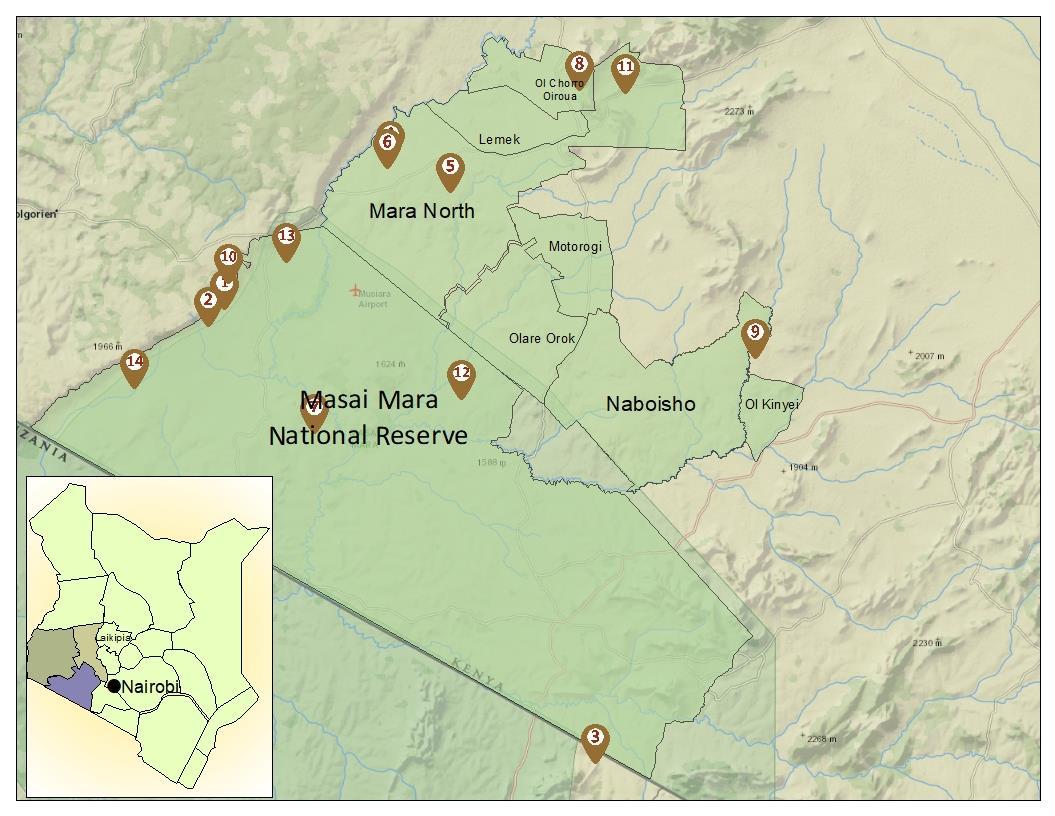

SWT/KWS Mara Mobile Vet Unit Treatment Locations September 2022
Buffalo Human wildlife Conflict Paltiklat Rhino Sanctuary
Rhino sanctuary staff in charge of the rhino monitoring team requested the Veterinary Unit to relocate a buffalo that was within the sanctuary. The adult male buffalo had on several occasions attempted to attack the rhino monitoring team posssibly as it tried to defend itself since it was lame and isolated within the enclosed sanctuary.
Immobilisation and Relocation
The buffalo was darted from a vehicle with 10 mg Etorphine and 180 mg Azaperone. The drugs took effect 7 minutes later with the buffalo in right lateral recumbency. It was blindfolded and transported in the shovel of a backhoe loader to the Maasai Mara National Reserve approximately 1 kilometre away. Anaesthesia was reversed with 30 mg Diprenorphine hydrochloride injected into the ear vein. The buffalo rose 3 minutes later.
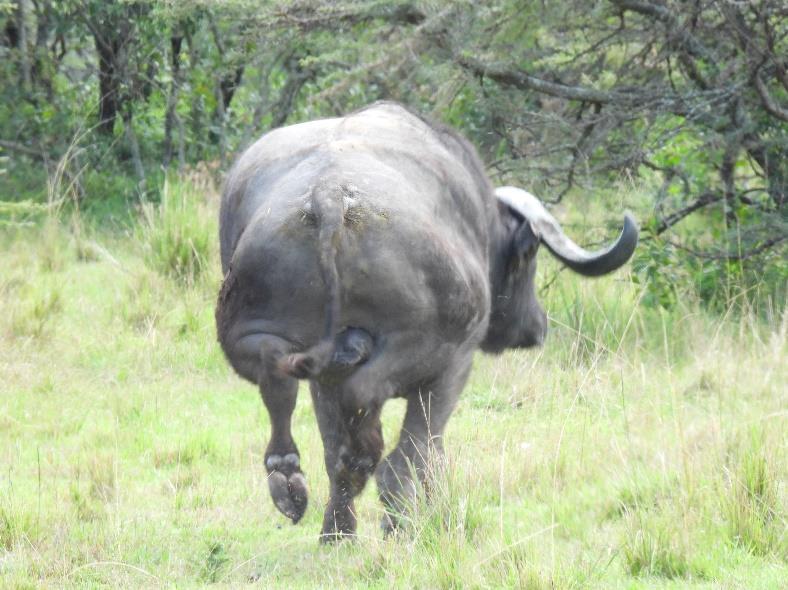

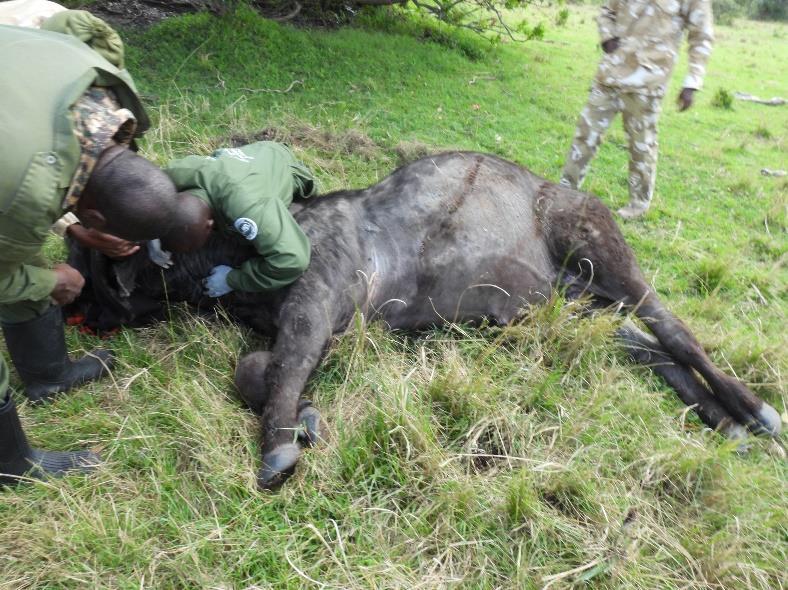

Prognosis
The translocation was carried out without any hitches. The buffalo has a good prognosis.
Case 1 11th September 2022
Zebra
Arrow Kawai Paltiklat Area
As the Veterinary Unit was translocating the buffalo under Case 1, rangers patrolling the area reported seeing a zebra that had been shot with an arrow.




Immobilisation, examination and treatment
The zebra was found within a herd grazing along the escarpment. The arrowhead tang was jutting out of the left thigh and bloody pus discharge was seen oozing from the wound. The zebra was darted from a vehicle with 5 mg Etorphine and 70 mg Azaperone. It was fully immobilized 6 minutes later and placed in right lateral recumbency to facilitate access to the wound. The arrowhead was barbed therefore a small incision was made at the entry wound then the arrowhead was carefully pulled out. The wound was cleaned with Hydrogen peroxide and Iodine. Green clay was then packed into the wound and Oxytetracycline sprayed topically. 4,000 mg Oxytetracycline and 30 mg Dexamethasone were injected intramuscularly. The zebra was revived with 15 mg Diprenorphine hydrochloride injected into the jugular vein. It rose 3 minutes later.
Prognosis
The zebra has a good prognosis.
Case 2 11th September 2022
Lion Human Wildlife Conflict
Maasai Mara National Reserve
The KWS Area Assistant Director requested the Mara Mobile Veterinary Unit to carry out an autopsy on a lion that was found dead within the National Reserve
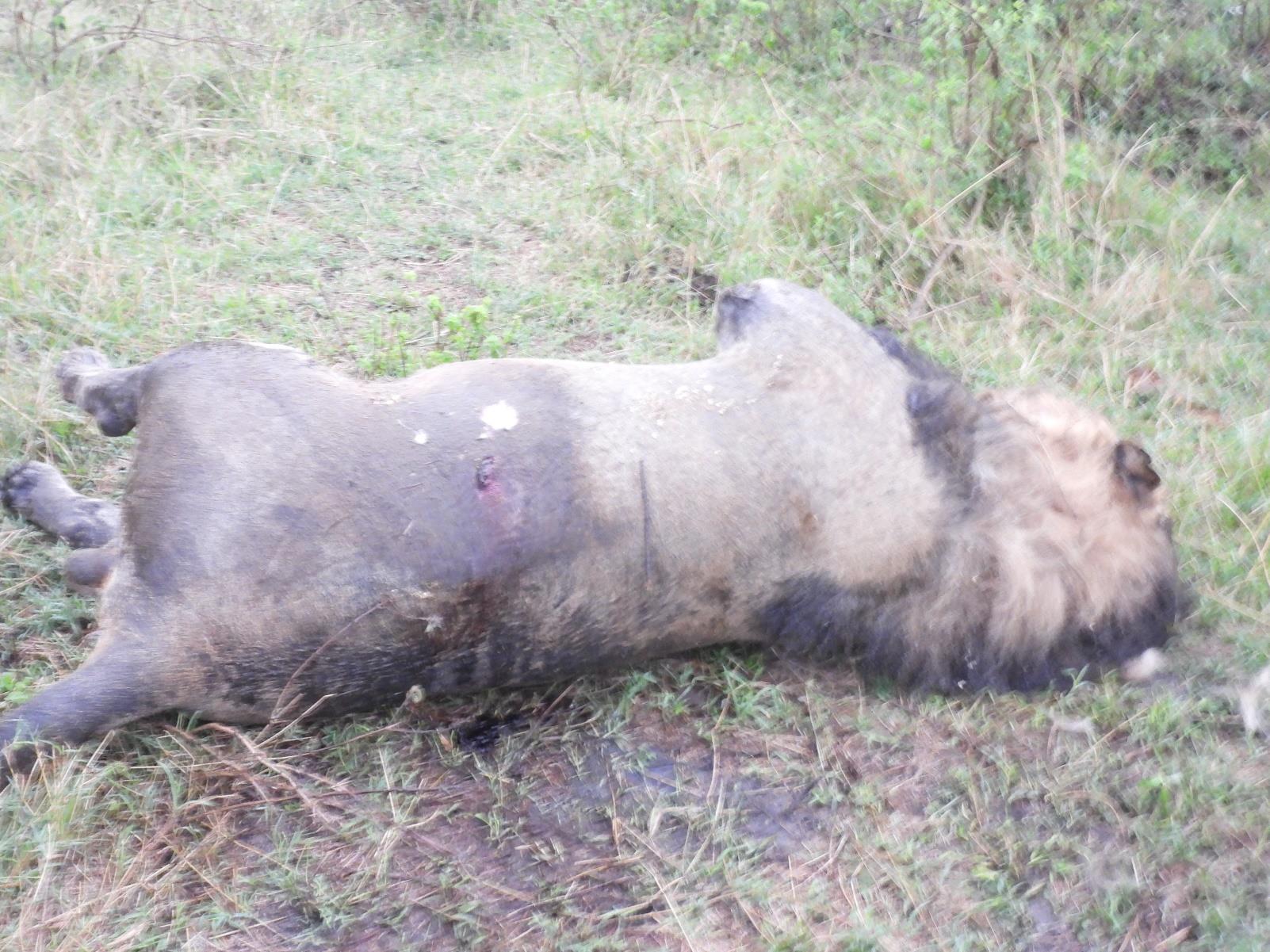
General findings
The adult lion was found lying on right lateral recumbency. It was in good body condition; a body condition score of 4/5 was given. A penetrating wound was observed on the left flank. No other external lesions were evident
Specific Post mortem findings
i. Huge hematoma within the abdominal cavity.
ii. Visceral organs were discoloured with hematoma blood.
Cause of death
The lion is suspected to have been hit with a sharp penetrating object, probably a spear due to human wildlife conflict, which resulted in the rupture of visceral blood vessels and hence the huge hematoma seen in the abdominal cavity.
Case 3 11th September 2022
Elephant Snared Mara North Conservancy
The Mara North Conservancy administration reported seeing an adult male elephant with a snare on its trunk. The elephant had eluded the team for 4 days and was therefore monitored until the Vet Unit arrived.



Immobilisation, examination and treatment
A plain double braided snare wire had bound the upper finger of the elephant’s truck and cut deep into the tissues It was darted from a vehicle with 20 mgs Etorphine. The dart landed on the right rump and several vehicles were used to prevent it from running into a thicket nearby. The elephant was fully immobilized after 8 minutes. The wire was cut off and carefully removed from the traumatic wound. The elephant also had 3 arrow wounds, one at the base of each tusk and another mid spine. These wounds had copious creamy pus but no arrowhead. All wounds were cleaned with water, disinfected with Hydrogen Peroxide and Iodine then sprayed with tetracycline before and after wet green clay was applied on them. 20,000 mgs Tetracycline hydroxide and 80 mgs Dexamethasone were administered intramuscularly then anaesthesia was reversed with 24 mgs Diprenorphine and 80 mgs Naltrexone. The elephant rose 2 minutes later.

Prognosis
The elephant has a good prognosis.
Case 4 16th September 2022
Elephant Arrow Mara North Conservancy
At different locations within the conservancy, Mara North Conservancy and Mara Elephant Program rangers tracked 2 elephants with arrow wounds as the Veterinary Unit attended to Case 4




Immobilisation, examination and treatment
Both elephants were darted from a vehicle, the adult female elephant received 18 mgs Etorphine while the adult bull elephant received 20 mgs Etorphine. The adult female elephant had an arrow wound mid left flank while the elephant bull had an arrow wound on the lateral side of the mid left hind limb. The wounds were septic with creamy pus, and they did not have foreign bodies. A plus sign incision was made at the entry point of the bull’s wound to facilitate draining of the wound during cleaning and disinfection. The wounds were cleaned with water, disinfected with Hydrogen peroxide and Iodine then Iodinated green clay was packed into them. Tetracycline wound spray was also applied topically. Each elephant received 60 mgs Dexamethasone and 20,000 mgs Tetracycline intramuscularly Anaesthesia was reversed with 80 mgs Naltrexone and 36 mgs Diprenorphine injected via the ear vein. The elephants recovered quickly from narcosis and walked away.
Prognosis
Both elephants have a good prognosis.
Case 5 & 6 16th September 2022
Cheetah Post mortem Mara Triangle

The Mara Vet Unit responded to a report of a snared giraffe that had been reported by the administrator of a camp within the Mara Triangle. Upon arrival at the camp, the administrator informed the Vet Unit that a 4 month old cheetah cub had been found dead near the camp that morning. The cheetah family comprised 3 other cubs and their mother, and they all seemed fine the previous evening. A post mortem examination was therefore carried out to determine the cause of death.
Important Autopsy Finding

i) The female cub was slightly dehydrated, had fair body condition (3/5), had a slightly pale mucus membrane, had no discharge from orifices, had no signs of diarrhoea and stiffness had set in.
ii) At the brisket area towards left elbow there was a patch of congested blood vessels just under the skin and on adjacent muscle fascia.
iii) The whole of GIT system was devoid of content. The mesentery vessels were heavily congested and omental fat was slightly gelatinous.
iv) The vital organs comprising the liver, spleen and kidney were heavily congested and dark red in colour. All their edges appeared slightly rounded depicting swelling. The kidney also appeared darker with marked demarcation of the cortex medullar junction.
v) No traumatic injury was visible on the whole skeleton including the skull.
vi) When cut the blood was darker and flowing without readily clotting.
Discussion
The congested patch near left elbow is suspected to be the point of injury. This injury is believed to have been caused by a poisonous bite. It is evident that the vital organs response was due to the injected poison. Empty GIT suggests that the cub had not eaten for at least three days despite the mother having a kill almost daily. The other three cub were seen to be more playful than the dead cub before the cub passed away
Tentative cause of death
Toxicity caused by poisonous bite most likely a venomous snake.
Case 7 16th September 2022
Rhino Natural Causes Olcholorua Rhino Sanctuary
The Head of Security reported that an adult male white rhino within the sanctuary was behaving unusually, the rhino was lying down, rolling about then rising, stumping and sweating. The rhino had displayed this behaviour on 17/9/2022 and later resumed normal behaviour. A similar bout ensued on 18/9/2022.



General observation
The adult was living with an adult female in an enclosed area. By the time the vet unit arrived, the male rhino had recovered from the painful bout. The Vet enquired into the rhino’s behaviour and health history from the administration, security and rangers/keepers. An inspection was carried out of the enclosure/sleeping quarters where the rhinos are held at night, the rhino’s water and wallowing troughs, grazing fields and pit latrines. The behaviour of the rhinos was also observed as they were herded from the grazing field to the sleeping quarters.
Conclusion

i) The rhino had suffered from 2 bouts of colic which refers to any pain emanating from the stomach/ abdomen.
ii) At the time of observation, the rhino was out of danger as normal behaviour was displayed. These included flehmen reaction, taking water, walking, obeying instructions and aggression towards female. The faecal material voided was of normal consistency, smell and volume.
Case 8 19th September 2022
Intervention, recommendations and way forward
The vet presided over a detailed educational session for the sanctuary personnel available including the assistant manager, security and animal keepers. The topics covered included: What is colic; Predisposing factors to colic; Types of colic; Causes of colic; Prevention/control of colic; and Record keeping.
The vet made the following recommendations:
i) Strictly adhere to routine practices which should be regular and offered at same predetermined time/periods.
ii) Regular provisions of minerals/ salt licks
iii) Clean palatable water provisions.
iv) Water troughs and any other equipment within the vicinity of the animals should be thoroughly cleaned on a regular basis.
v) Vital supplementation such as lucerne should be introduced.
vi) Sleeping quarter perimeter integrity should be ensured by carrying out timely repairs
vii) Animal droppings should be disposed off at a designated area away from entrance of the enclosure.

viii)Kitchen wastes both solid and fluid should be disposed off in a manner that ensures they are not available to the rhinos.
ix) Notices warning visitors not to feed the rhinos or carry/ drop any edible material or food in the grazing fields should be placed strategically.
x) The rhino’s behaviours should be recorded daily and regularly so any information on abnormal displays can be gathered swiftly for timely intervention measures to be instituted.

xi) An animal health technician/ assistant should be posted for health status observations of the rhinos
The way forward:
i) Blood sample should be taken for comprehensive analysis. This should not be limited to blood profile, biochemistry, hemoparasites, Serum for kidney and liver function test.
ii) Administer prophylaxis against colic, tryps, mineral deficiency and bacterial infection.
iii) Captive facility wellness assessment should be carried out by the KWS HQs TEAM as soon as possible
This should outline recommendations for appropriate remedial actions to be taken by the sanctuary.
Prognosis
The rhino has a fair prognosis.
Elephant Natural Causes Naibosho Conservancy
The Naibosho Conservancy’s Head of Security informed the Mara Veterinary Unit that tourists had spotted an elephant exhibiting lameness on the left hind leg.

Immobilisation, examination and treatment

The elephant was exceptionally shy and hid in a thicket for one and a half hours before it was successfully driven out and darted with 20 mgs Etorphine. The dart landed on right rump causing the elephant to run back to the thickets. The elephant was tracked on foot until it went down on right lateral recumbency 8 minutes post darting.
The said limb was thoroughly examined for soft tissue and bone injuries, but no injuries were seen. It was observed that the knee joint had not been flexed completely during ambulation. The Vet determined that the left hind leg was slightly longer than the right counterpart hence the deceptive lameness. A minor inconsequential sole tear was observed on the same limb, but it posed no threat pathologically. The tear was sprayed with Tetracycline wound spray topically. 10,000 mgs Tetracycline Hydrochloride and 40 mgs Dexamethasone were administered intramuscularly. 60 mgs Dexamethasone was also injected via ear vein.
Anaesthesia was reversed 20 minutes post darting with 48 mgs Diprenorphine injected into the jugular vein. The elephant rose 2 minutes later and walked away.
Prognosis
The elephant has a good prognosis.
Case 9 20th September 2022
Zebra Snared Paltiklat Area, Masai Mara
The OC Paltiklat Rhino Sanctuary reported a snared zebra seen outside the sanctuary. The Mara Veterinary Unit attended to the zebra with assistance from the Mara Elephant Project helicopter.



Immobilisation, examination and treatment
The zebra was darted from a vehicle with 5mgs Etorphine and 70mgs Azaperone. The dart landed on the left shoulder with the zebra going down on right lateral recumbency 5 minutes later.
The zebra had a tight wire snare around the neck, fortunately the snare had not caused any visible injury. The zebra was in good health, and it was nursing a foal less than 2 months old therefore no drugs were administered after the snare was removed.

Anaesthesia was reversed with 18mgs Diprenorphine injected into the jugular vein. The zebra mare was up in 2 minutes and called out for its foal and the rest of the herd nearby.
Prognosis
The zebra has a good prognosis.
Case 10 22nd September 2022
Elephant Spear Mara North Conservancy
The Mara Elephant Project (MEP) security team saw this lame elephant the day earlier, but due to difficult terrain, distance from the camp and fast falling darkness, intervention was postponed to the following day. The elephant was severely lame on the right forelimb and could not be pushed out of the bush therefore a helicopter was availed by MEP to facilitate darting.
Immobilisation, examination and treatment
The elephant was darted from a helicopter with 20 mgs Etorphine. The dart landed on the right rump. The elephant was tracked through the bush by helicopter until it assumed a dog sitting posture 9 minutes post darting. The lame right forelimb was significantly swollen, a spear wound was observed on the medial aspect of the fetlock joint. This made the elephant to exhibit leg carrying lameness. Another spear injury, which was not very deep, was observed on the right scapular area.


The elephant was positioned in left lateral recumbency, blindfolded and doused with water to cool its body. The wounds were cleaned with water, disinfected with Hydrogen peroxide and Iodine then sprayed with Tetracycline wound spray before and after Iodinated wet green clay was packed into them. 20,000 mgs Tetracycline hydrochloride, 30 mgs Dexamethasone and 50 ml Multivitamin were administered intramuscularly. 50 mgs Dexamethasone was also injected via ear vein then anaesthesia was reversed with 80 mgs Naltrexone and 24 mgs Diprenorphine. The elephant rose 3 minutes later and limped off.
Prognosis
The elephant has a good prognosis.
Case 11 22nd September 2022
Lion Human wildlife conflict


Maasai Mara National Reserve


Immobilisation, examination and treatment
The lion was found in sternal recumbency, it was observed to favour right recumbency The lion had taken refuge in a thicket about 40 meters from where it was attacked. At the attack site, there was a shallow, ovoid and dry ditch. A herding stick, a few stones, 2 wooden handled spears and an additional spear with a detached metallic head were retrieved from the ditch. These crude weapons had been used to attack the lion. The lion was darted with 400 mgs Ketamine and 8 mgs Medetomidine on the right thigh, it did not move from where it lay when the dart landed. The drugs took effect after 10 minutes, it was blindfolded and moved to a place with better shade for treatment. The lion had a 15 cm deep penetrating spear wound to the right of its scrotum on its right hind limb. There was also a skin deep cut just posterior to right forelimb and a 3rd deep spear injury mid spine on the left flank. This injury had penetrated the muscles creating a dead pocket. All wounds were cleaned with water, disinfected with Iodine, sprayed with Tetracycline wound spray, packed with green clay then simple interrupted stitches were used to appose the gaping wounds. Tetracycline wound spray was then sprayed topically.
Case 12 23rd September 2022
The Ag. Senior Warden Masai Mara N.R. reported a young, injured lion The lion had sustained spear injuries which were suspected to have been inflicted by illegal herders driving their cattle into the reserve at night.
During treatment cold water was poured on the lion’s body to cool it. 3,750 mgs Amoxicillin, 40mgs Dexamethasone and 25 ml Multivitamin were administered intramuscularly. 30 mgs Ivermectin was also injected subcutaneously Anaesthesia was reversed 1 hours post darting with 12.5 mgs Yohimbine injected intravenously and 10 mgs Atipamezole administered intramuscularly. The lion was completely aware of its surrounding and on sternal recumbency in 10 minutes. It was left under the shade.
Prognosis
i) The lion has a fair prognosis if the posterior and mid spine penetrating injuries did not puncture internal organs like the bladder and spine respectively.
ii) However, if these organs sustained injury, the lion has a guarded prognosis since it may succumb to its injuries due to peritonitis and posterior paralysis respectively
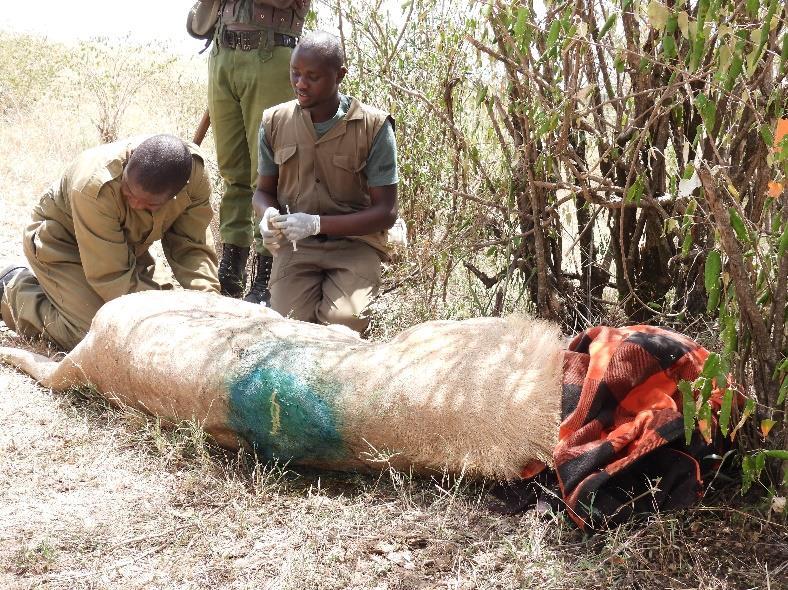

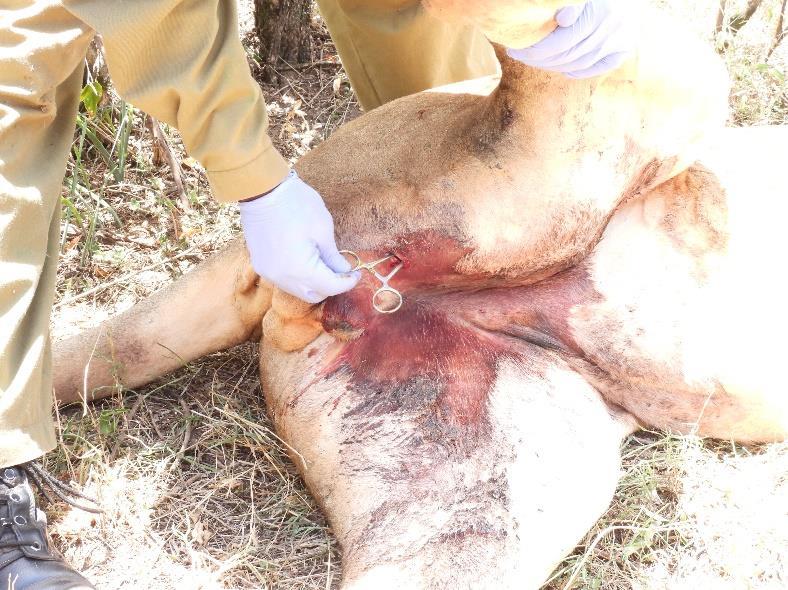

iii) Additionally, it may have a guarded prognosis if its internal organs were injured since it may not be able to defend itself against undue aggression from hyenas and territorial male(s).
The lion will be monitored to assess its progress and if posterior paralysis will prevail, euthanasia will be considered.
Eland Snared Mara Triangle
The Head of Security, Mara Conservancy informed the Veterinary Unit of a female eland with a wire snare around the neck. The Vet Unit attended the eland after treating the lion under Case 12.




Immobilisation, examination and treatment
The eland was darted with 8 mgs Etorphine and 200 mgs Azaperone. The dart was poorly placed due to the long darting distance. The eland was therefore darted again with 5 mgs Etorphine and 150 mgs Azaperone after 15 minutes. The drugs took effect 5 minutes post darting. The eland had a loose snare around the neck with no injury. Once the snare was removed, anaesthesia was reversed with 40 mgs Naltrexone and 24 mgs Diprenorphine injected into the jugular vein. The eland got up 3 minutes later.
Prognosis
The eland has a good prognosis.
Case 13 23rd September 2022
Zebra Snared Mara Triangle

The
Immobilisation, examination and treatment
The zebra foal was darted with 3 mgs Etorphine and 40 mgs Azaperone. It went down on left lateral recumbency 5 minutes post darting. The snare was cut off then carefully taken off the septic, foul smelling traumatic wound. The wound was cleaned with water, maggots were manually removed, then the wound was disinfected with Hydrogen Peroxide and Iodine. Both Tetracycline wound spray and Tetracycline wound powder were applied on the wound. 15 ml Multivitamin, 24 mgs Dexamethasone and 2,250 mgs Amoxicillin were administered intramuscularly. 110 mgs Ivermectin was also smeared on the wound following disinfection to dislodge any unretrieved maggot. Additionally, 30 mgs Ivermectin was injected subcutaneously to control internal and external parasites. Anaesthesia was reversed with 12 mgs Diprenorphine administered intravenously. The foal rose 3 minutes later and re joined its herd.



Prognosis
The zebra foal has a good prognosis.
Case 14 23rd September 2022
Head of Security, Mara Conservancy informed the Veterinary Unit of a zebra foal with a wire snare around the neck. The foal had a severe traumatic wound caused by the snare
Roan Natural Causes Ruma Roan Sanctuary
The adult male roan antelope was seen with a wound on the left side of the tail base on 14/9/2022. The injured roan was one of several antelopes recently translocated from Tanzania. The wound was believed to have been sustained during a territorial fight with another male roan antelope that was found dead on 20/9/2022. The Vet was flown to Ruma Roan Sanctuary by KWS on 26/9/2022 and attended to injured animal the following day after several attempts to dart the shy and elusive antelope.
Immobilisation, examination and treatment
The roan antelope was darted with 7mgs Etorphine and 80mgs Azaperone. The animal went down fast on sternal recumbency a minute post darting raising concerns as to whether it was a poor darting candidate. It was pushed onto right lateral recumbency, and the head was pinned down to facilitate quick treatment. The antelope’s vitals stabilized quickly with regular breathing rhythm resuming. The wound was septic, foul smelling and maggot infested. A 12 cm deep central canal was observed on the wound The wound was thoroughly cleaned and disinfected with Hydrogen Peroxide and Iodine. Maggots around the edges of the wound were removed then the wound was smeared with 100 mgs Ivermectin to kill any remaining maggot. Tetracycline wound spray was applied topically thereafter. 3,750 mgs Amoxicillin, 30 mgs Dexamethasone and 25 ml Multivitamin were injected intramuscularly. 50 mgs Ivermectin was also injected subcutaneously to control internal and external parasites. The dart was retrieved, and the dart wound was sprayed with Tetracycline wound spray. An abscess on the inner side of left hock joint dorsally was noted. The abscess was cut open and smelly creamy pus was expressed. It was then flushed with Hydrogen peroxide and Iodine. Anaesthesia was reversed with 40 mgs Naltrexone and 18 mgs Diprenorphine injected into ear vein. The roan antelope recovered from anaesthesia 2 minutes later and trotted away.
Prognosis
The roan antelope has a fair prognosis. Monitoring was advised with a possibility of review between the 10th and 15th day if response to initial treatment is slow.


Case 15 27th September 2022




 Report by Dr. Ndambiri Ephantus
Report by Dr. Ndambiri Ephantus























































